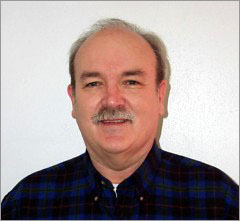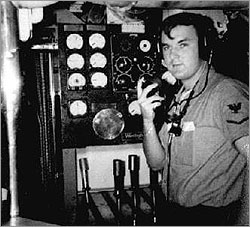
|
 |
 |
(back to Life on a Submarine) The morning before the Cuban Missile Crisis broke, I was standing topside mid-watch—midnight to 4 a.m. at the brow (gangplank)—when I noticed lights coming on at various buildings along the waterfront at the Key West Submarine Base. Then cars and trucks were seen whizzing about, going to each submarine tied alongside a pier. Presently a car came alongside the USS Chopper, and a hassled-looking officer asked for Chopper's duty officer, who was then instructed to recall all our officers and crew, to stand by to take on 30 days of patrol supplies and be ready to depart by 8 a.m. All submarines were apparently given the same instructions. Not long afterwards, a large truck roared up to Chopper, and all hands on board commenced loading boxes of food, foul weather gear, spare parts, and fuel. At approximately 8 a.m., most of the submarines had their engines roaring, and the smoke hung heavy over the waterfront as the first of SUBRON 12's submarines got underway. [SUBRON stands for SUBmarine squadRON.] One submarine had been in minor overhaul alongside the pier, with her propellers removed, and in the haste to make ready, the propellers were re-installed backwards. As they tried to get underway, the "all back 1/3" became "all back 2/3," "all back FULL," as the submarine drove ahead and slowly plowed into the seawall. They rejoined the squadron at sea later.
The "special team" was kept relatively isolated in the forward torpedo room, but Chopper's mission, as I understood it, was to deliver the UDT to a place near Havana harbor, where they would "lock out" of the forward escape trunk and swim into and sabotage ships and facilities in the harbor, should we receive orders to do so. Chopper then took her position in the blockade. After a week or so, Russia withdrew her missiles, and the Chopper returned to Key West. Later that year, President Kennedy made a visit to Key West Naval Station and boarded the Chopper. He spoke to the Captain and officers, thanking them for doing their duty, and departed. —Patrick Householder served as an Electricians Mate between 1962 and 1963 aboard the USS Chopper (SS-342), a diesel-snorkel GUPPY boat. [GUPPY stands for Greater Underwater Propulsion Power.] He now lives in Issaquah, Washington. Continue: Bill Whalen
See Inside a Submarine | Can I Borrow Your Sub? Sounds Underwater | Life on a Submarine Resources | Transcript | Site Map | Submarines Home Editor's Picks | Previous Sites | Join Us/E-mail | TV/Web Schedule | About NOVA Watch NOVAs online | Teachers | Site Map | Shop | Search | To Print PBS Online | NOVA Online | WGBH © | Updated May 2002 |
 Patrick Householder
Patrick Householder
 Patrick Householder in the Maneuvering Room of the
USS Chopper.
Patrick Householder in the Maneuvering Room of the
USS Chopper.